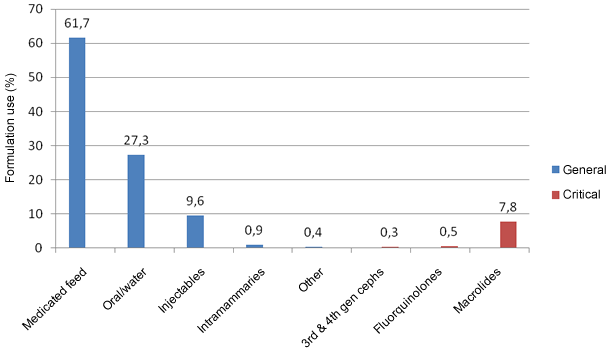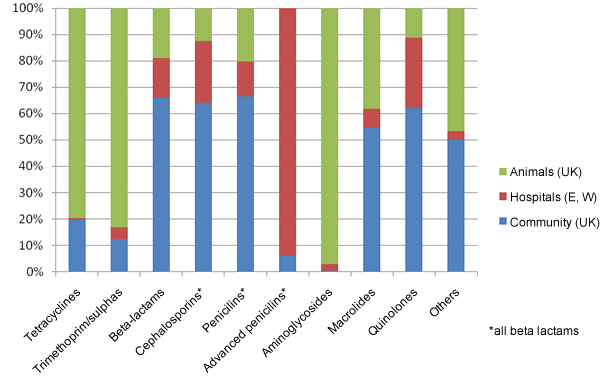Introduction
The use of antimicrobials in animals is considered a necessity to treat infections and maintain health and ultimately their welfare but when it comes to production animals like the pig, is there an over-reliance on the use of antibiotics to cover up failings in management, environment even biosecurity? Are public perceptions changing? Is it timely to review and revise the way antimicrobials are used in pig production?

The European Commission is reviewing and consulting how antimicrobials are used in veterinary medicine following the release of their 12 point programme (EC, 2011) and this might give us an insight into where their deliberations will take them. There is a lot of political activity also going on with some Member States (MS) being particularly active in controlling (Denmark) or reducing the use of antibiotics (Netherlands) by banning feed premixes and some have voluntarily restricted the use of 3rd and 4th generation cephalosporins (Denmark, Sweden, France) and the fluoroquinolones (Denmark). The European Parliament have called for a ban on preventive use of antimicrobials but it has not been defined precisely what they mean by preventive use. Should it be restricted to just veterinary use, what about medical use?
The human doctors are under a lot of pressure, regarding antimicrobial resistance, not only in cases which apply to human medicine such as tuberculosis, gonorrhoea etc but also methicillin resistant Staphylococcus aureus (MRSA), which is particularly rife in certain hospital situations. This is probably associated with their own overuse of antibiotics and poor hospital hygiene. It does not help the veterinary cause that MRSA was found in pigs, poultry and calves but fortunately they were mainly different from the human clones and the spread was mainly limited to people associated with farm animal production and it has not spread amongst the general population. Extended spectrum beta lactamase (ESBL) producing bacteria such as Escherichia coli but particularly in humans Klebsiella pneumoniae appears to have replaced the MRSA concerns. There is a high risk that these genes can be transmitted between E. coli via plasmid and thereby get into human E. coli from contaminated food. Generally, in most MS, the level of ESBLs found in pigs, poultry and cattle were low but in some MS and particularly in chickens, high levels (up to 30%) of ESBL resistant E. coli clones were found in chickens in Spain, thought to be associated with ‘off-label’ unlicensed use of ceftiofur (3rd generation cephalosporin) in chicks. The European Medicines Agency EMA) has already responded but this does not help support the image of responsible use in veterinary medicine. Fortunately, the increase in carbapenemase resistance seen in man particularly K. pneumoniae, Pseudomonas aeruginosa etc are primarily linked to Asian clones coming into Europe and are definitely not linked to veterinary use but human medicine’s own limitations and globalisation.
The present
Let us look at the key point proposals and especially those related to veterinary use of antimicrobials:
| 1. Strengthen the promotion of the appropriate use of antimicrobials in all Member States. |
| 2. Strengthen the regulatory framework on veterinary medicines and on medicated feed. |
| 3. Introduce recommendations for prudent use in veterinary medicine, including follow up reports. |
| 4. Strengthen infection prevention and control in healthcare settings. |
| 5. Introduce a legal tool to enhance prevention and control of infections in animals in the new Animal Health Law. |
| 6. Promote, in a staged approach, unprecedented collaborative research and development efforts to bring new antimicrobials to patients. |
| 7. Promote efforts to analyse the need for new antibiotics into veterinary medicine. |
| 8. Develop and/or strengthen multilateral and bilateral commitments for the prevention and control of AMR in all sectors. |
| 9. Strengthen surveillance systems on AMR and antimicrobial consumption in human medicine. |
| 10. Strengthen surveillance systems on AMR and antimicrobial consumption in animal medicine. |
| 11. Reinforce and co-ordinate research efforts. |
| 12. Survey and comparative effectiveness research. |
Future perspectives
Points 1 and 3 are linked together to promote responsible use of antibiotics and EPRUMA is core to this as well as national bodies like the UK’s RUMA. This is the one way that we will be able to maintain our current armoury against infectious diseases.
Point 2 is unclear at this stage. Should there be dissociation between vets making a profit from antimicrobial sales and the pharmacists supply them instead? This is not as clear cut as one might think. The Danes have introduced this recently but the Italians did it back in the nineties and they still have some major resistance issues. Corporate, integrated production of pigs may also play a role. Feed premixes (see Figure 1) are generally supplied to feed and supplement companies directly by the pharmaceutical companies, bypassing the vet and premixes form the bulk of antimicrobial use. The EC has not come out against medicated feed and it has been reported that it considers if properly regulated, it is a valuable route for treatment. Oral powders, used on feed are not considered a favourable, reliable option. The carryover of low levels of antimicrobial residues in the mill and contaminating other feed is likely to be controlled, hopefully, to existing levels for anticoccidials of 3 or 1% depending on risk status. Should advertising of antibiotics products to farmers be prohibited? This is likely to be mandatory.
Figure 1. Veterinary antimicrobial use by route of medication and ‘critical’ drug use in 2010 in the UK (VMD, 2011)

Point 4 applies mainly to human healthcare and improvements need to be made here, especially regarding hospital hygiene.
Point 5 is worrying, as the devil is in the detail. It could be critical at the farming level. Farmers need to improve the way they produce pigs, without the continuous support of antimicrobials. The broiler industry is being forced to do this with the supermarkets being the main drivers. Biosecurity is also essential. It is difficult to make investments in new buildings however, when the economy is under pressure, as has been demonstrated by the ban on layer cages in the EU. With the likelihood of feed prices soaring, profit margins will be under attack and investment slowing.
Points 6 and 7 are related – do vets need new antibiotics? Probably yes but who is going to develop any for veterinary medicine in the EU? I think we will largely have to rely on what is available already in other MS and mutual recognition registration.
Points 9, 10, 11 and 12 are all linked. It is considered that there will be more monitoring of veterinary use of antimicrobials possibly down to the practice/vet level. High users will be challenged, as in Denmark and the Netherlands and possibly disciplined. There does need further research and cooperation between the veterinary and medical sides to identify the level of transmission between each other. I am of the camp that suggests that it is comparatively small (see Figure 2) but this needs to be properly determined.

Figure 2. Comparison of human (community UK and hospital England and Wales) use with animal use (VMD, 2010)

More science is going to help us make better decisions and improve our understanding of the risks. Let’s hope this is the case and the EC does not make the EU pig industry less competitive than it already is.



